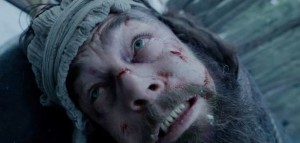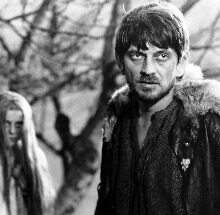
I had put off going to see The Revenant for awhile, thinking that it would stick around, and in fact it did, winning three Oscars along the way, for director, actor, and cinematographer. Now, I sometimes approach mainstream films, even the films with a lot of brouhaha like this one, with skepticism. When I finally saw The Revenant last weekend, I was amazed at what a beautiful, vigorous and exciting piece of work it is. The director is Alejandro González Iñárritu, who won for Birdman last year. I liked Birdman, but this movie—this is filmmaking on a whole other level.
Based on a novel which was in turn loosely based on the 1823 survival story of an actual frontiersman, The Revenant opens in the wilderness of Montana with a party of fur trappers being ambushed by Indians. This disaster leaves the party stranded in the forest, trying to get to a South Dakota fort on foot while being tracked by the hostile Indians. We soon discover that Hugh Glass, the group’s scout, played by Leonardo DiCaprio, has aroused the deep hostility of a greedy and profane trapper named Fitzgerald, played by Tom Hardy. Later, Glass has the misfortune of coming between a huge grizzly bear and her cubs, and in one of the most jaw-dropping scenes I’ve ever witnessed, he is severely mauled by the animal. After further misfortunes too complicated to relate, Fitzgerald throws dirt on the still breathing Glass, abandoning him in the middle of nowhere, with no weapons and no food, and assuming of course that he will soon die. The rest of the film recounts Glass’s incredible struggles to survive, get to safety, and take his revenge on Fitzgerald.
Over the years I’ve grown weary of computer-generated imagery, which has had the odd effect of making movie spectacle look fake and uninvolving. In The Revenant, with the exception of the bear attack and one sequence involving a horse, everything is shot in available light, outdoors in the actual wilderness, with real and often very harsh weather, and the sense of veracity this produces is breathtaking. The camera moves with seeming ease through the most forbidding landscapes— Iñárritu has really outdone himself here. DiCaprio is excellent, conveying every bit of physical and mental agony that the part calls for, and everyone else in the cast is near flawless as well. The cinematographer is Emmanuel Lubezki, who has done a lot of great work with Terrence Malick, among others—and sometimes this film reminds me a little of Malick, when DiCaprio’s character stops in exhaustion and we see shots of the tall trees from below, with flashbacks to his past life with a Native American woman with whom he had a son.
The script has seasoned the simple revenge plot with a feeling of tragedy surrounding the Indians and their brutal mistreatment by whites. There is no sentimentality; the human capacity for evil is depicted starkly and without glory. And if the tale, in the end, is not a profound one, the execution, the bold and confident cinematic technique, makes it seem so. Go see The Revenant in a theater while you have the chance—this is solid moviemaking craft at its best.






